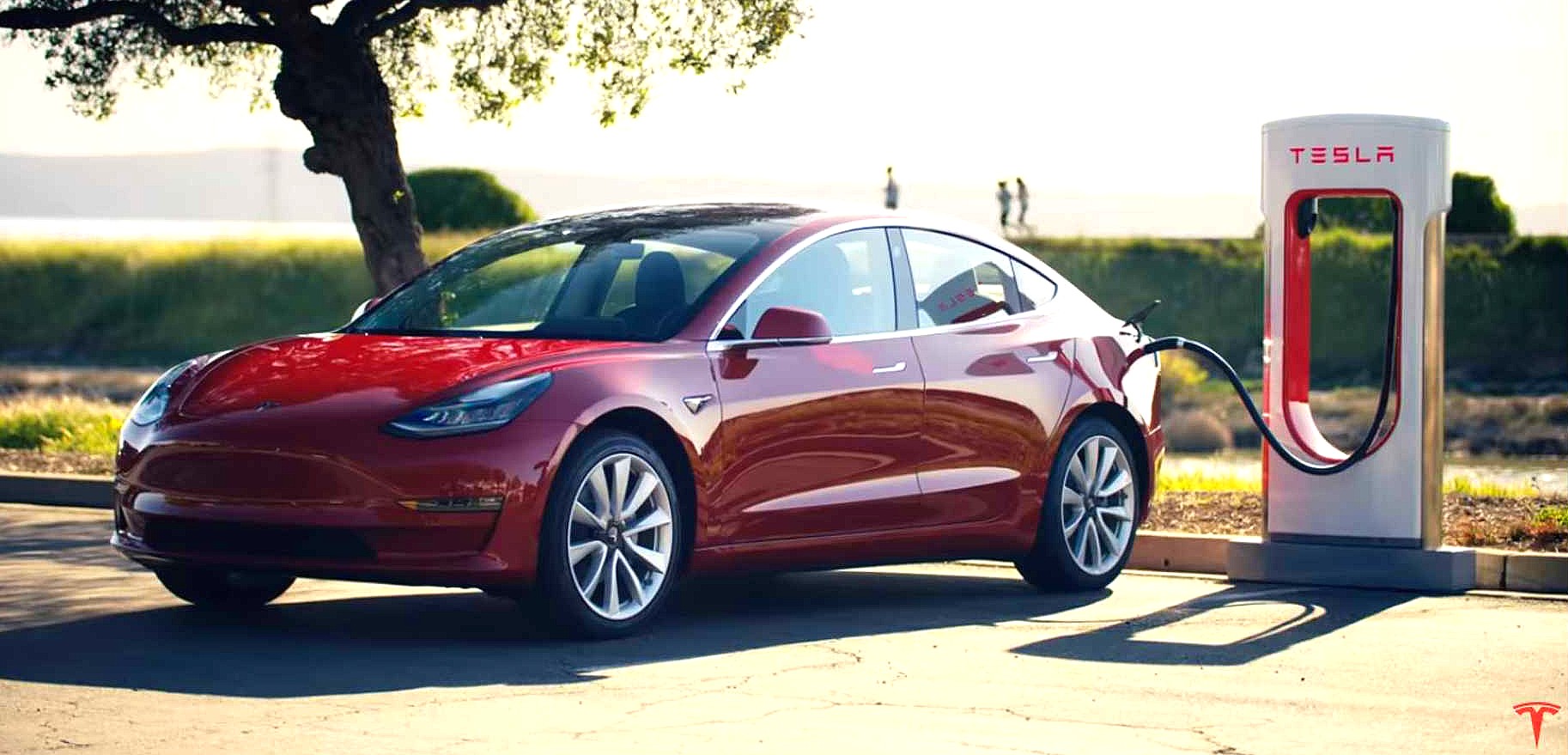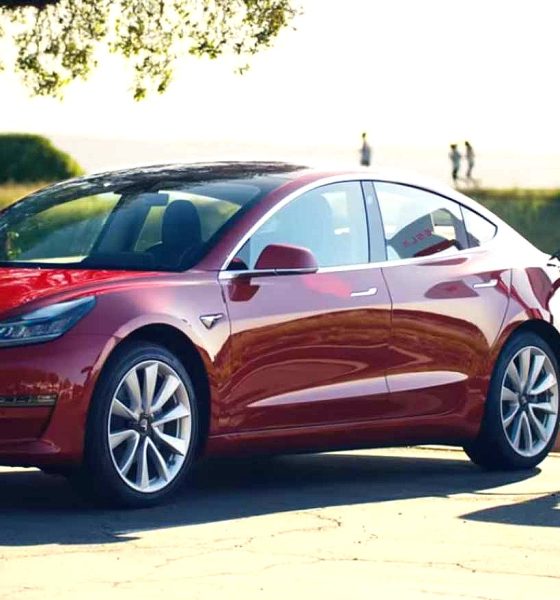

News
Tesla destroys German critic’s electric car prejudice after Model 3 test drive
German automotive veteran Nando Sommerfeldt has not had good experiences with electric cars. At one time, the electric vehicles he was testing ended up running out of charge, making him stranded in the middle of a trip. Other vehicles proved too slow to charge, testing his family’s patience. Sommerfeldt has reservations about electric cars, even a prejudice, if you may, but it only lasted until he drove a Tesla Model 3.
The Silicon Valley-based electric car maker sent a bold message to the auto veteran, offering to change his mind about electric cars. “We would like to convince you otherwise. Our impression is that you simply have not tested the ‘right electric cars’ yet,” Tesla wrote. That’s a bold statement, and Sommerfeldt opted to take the offer. Tesla provided the EV critic with a Model 3 Performance, one of its latest vehicles that currently sells for 69,000 euros in Germany.
Being “spoiled” by vehicles from premium manufacturers such as Mercedes-Benz and BMW, Sommerfeldt was largely unimpressed with the build quality of the Model 3. In his review, which was published at German publication Welt.de, Sommerfeldt complained about the panel gaps in the car, and he argued that while the white seats of the Model 3 were good, they do not compare favorably to the seats of the Audi e-tron. “The workmanship of body, interior, actually everything, is not up to premium standards,” he wrote. Nevertheless, with his evaluation of the vehicle’s build quality out of the way, the EV critic started driving the electric sedan.

It took 50 kilometers (31 miles) before his prejudices against electric cars started to fade. Even with the electric revolution underway today, there is still a persistent belief that EVs don’t drive as well as the best gas-powered vehicles on the market. “What nonsense. The Model 3 drives terrific,” Sommerfeldt declared. German industry expert Ferdinand Dudenhöffer from Center Automotive Research (CAR) highlighted Sommerfeldt’s observations. “The car is much better than all models of electric competition. The technical lead is easily four to five years. Range and driving pleasure are unmatched,” he said.
Elaborating on his experience, Sommerfeldt noted that the Model 3 feels like a sports car, an “extremely fast sports car.” This is quite notable considering that the vehicle is a family car at its core. But it’s not just the vehicle’s driving dynamics that impressed the EV critic. In terms of bleeding-edge technology inside the car, the Model 3 does not disappoint either. Industry expert Stefan Bratzel of the Center of Automotive Management (CAM) noted that the migration of car buyers from traditional vehicles to electric cars like Tesla is due to veterans being unable to offer similar innovations. “The future is offered here (at Tesla), which the Germans have not been able to do so far,” Bratzel said.

Beyond the excellent driving dynamics and the technology in the Model 3, perhaps what really removed the EV critic’s prejudice against electric cars was Tesla’s Supercharger Network. During his time with the vehicle, Sommerfeldt took his family out on a road trip once more, and this time around, they did not have to wait for hours on end for their vehicle to charge. Using one of Tesla’s Superchargers, Sommerfeldt and his family opted for a quick coffee and ice cream break, and by the time they returned to the Model 3, it had already gained 300 km (186 miles) of additional range. Sommerfeldt found the Supercharger Network’s design well-placed for long trips, and the Tesla community as a whole pleasant to interact with.
Dudenhöffer noted that among electric car makers, Tesla is the one that really thought about the big picture when they released their vehicles. Teslas, while not capable of charging at speeds similar to a gas-powered car yet, can charge at their owner’s homes (allowing drivers to leave with a “full tank” every day), and the company has backups in place if the Supercharger Network is unevailable. “Right from the beginning, the company had a clear plan of where its customers’ traffic flows. The Tesla owner can also refuel at all the other pillars of this country. But first of all, it would probably be too slow for him. And second, he does not need them,” he said. This is a particularly notable point for Sommerfeldt, as he admits to having deep range anxiety issues due to his past experiences with EVs. These issues, he found, were nonexistent with the Model 3.
With range anxiety gone thanks to the Supercharger Network and its contingencies, Sommerfeldt noted that Tesla drivers could trust their vehicles once more. And that, for Germany’s car buying public, at least, is a very big deal. “This Tesla destroys all my prejudices against the electric car,” he wrote.

News
Tesla FSD v14.2.2 is getting rave reviews from drivers
So far, early testers have reported buttery-smooth drives with confident performance, even at night or on twisty roads.

Tesla Full Self-Driving (Supervised) v14.2.2 is receiving positive reviews from owners, with several drivers praising the build’s lack of hesitation during lane changes and its smoother decision-making, among others.
The update, which started rolling out on Monday, also adds features like dynamic arrival pin adjustment. So far, early testers have reported buttery-smooth drives with confident performance, even at night or on twisty roads.
Owners highlight major improvements
Longtime Tesla owner and FSD user @BLKMDL3 shared a detailed 10-hour impression of FSD v14.2.2, noting that the system exhibited “zero lane change hesitation” and “extremely refined” lane choices. He praised Mad Max mode’s performance, stellar parking in locations including ticket dispensers, and impressive canyon runs even in dark conditions.
Fellow FSD user Dan Burkland reported an hour of FSD v14.2.2’s nighttime driving with “zero hesitations” and “buttery smooth” confidence reminiscent of Robotaxi rides in areas such as Austin, Texas. Veteran FSD user Whole Mars Catalog also demonstrated voice navigation via Grok, while Tesla owner Devin Olsen completed a nearly two-hour drive with FSD v14.2.2 in heavy traffic and rain with strong performance.
Closer to unsupervised
FSD has been receiving rave reviews, even from Tesla’s competitors. Xpeng CEO He Xiaopeng, for one, offered fresh praise for FSD v14.2 after visiting Silicon Valley. Following extended test drives of Tesla vehicles running the latest FSD software, He stated that the system has made major strides, reinforcing his view that Tesla’s approach to autonomy is indeed the proper path towards autonomy.
According to He, Tesla’s FSD has evolved from a smooth Level 2 advanced driver assistance system into what he described as a “near-Level 4” experience in terms of capabilities. While acknowledging that areas of improvement are still present, the Xpeng CEO stated that FSD’s current iteration significantly surpasses last year’s capabilities. He also reiterated his belief that Tesla’s strategy of using the same autonomous software and hardware architecture across private vehicles and robotaxis is the right long-term approach, as it would allow users to bypass intermediate autonomy stages and move closer to Level 4 functionality.
News
Elon Musk’s Grok AI to be used in U.S. War Department’s bespoke AI platform
The partnership aims to provide advanced capabilities to 3 million military and civilian personnel.

The U.S. Department of War announced Monday an agreement with Elon Musk’s xAI to embed the company’s frontier artificial intelligence systems, powered by the Grok family of models, into the department’s bespoke AI platform GenAI.mil.
The partnership aims to provide advanced capabilities to 3 million military and civilian personnel, with initial deployment targeted for early 2026 at Impact Level 5 (IL5) for secure handling of Controlled Unclassified Information.
xAI Integration
As noted by the War Department’s press release, GenAI.mil, its bespoke AI platform, will gain xAI for the Government’s suite of tools, which enable real-time global insights from the X platform for “decisive information advantage.” The rollout builds on xAI’s July launch of products for U.S. government customers, including federal, state, local, and national security use cases.
“Targeted for initial deployment in early 2026, this integration will allow all military and civilian personnel to use xAI’s capabilities at Impact Level 5 (IL5), enabling the secure handling of Controlled Unclassified Information (CUI) in daily workflows. Users will also gain access to real‑time global insights from the X platform, providing War Department personnel with a decisive information advantage,” the Department of War wrote in a press release.
Strategic advantages
The deal marks another step in the Department of War’s efforts to use cutting-edge AI in its operations. xAI, for its part, highlighted that its tools can support administrative tasks at the federal, state and local levels, as well as “critical mission use cases” at the front line of military operations.
“The War Department will continue scaling an AI ecosystem built for speed, security, and decision superiority. Newly IL5-certified capabilities will empower every aspect of the Department’s workforce, turning AI into a daily operational asset. This announcement marks another milestone in America’s AI revolution, and the War Department is driving that momentum forward,” the War Department noted.
News
Tesla FSD (Supervised) v14.2.2 starts rolling out
The update focuses on smoother real-world performance, better obstacle awareness, and precise end-of-trip routing, among other improvements.

Tesla has started rolling out Full Self-Driving (Supervised) v14.2.2, bringing further refinements to its most advanced driver-assist system. The new FSD update focuses on smoother real-world performance, better obstacle awareness, and precise end-of-trip routing, among other improvements.
Key FSD v14.2.2 improvements
As noted by Not a Tesla App, FSD v14.2.2 upgrades the vision encoder neural network with higher resolution features, enhancing detection of emergency vehicles, road obstacles, and human gestures. New Arrival Options let users select preferred drop-off styles, such as Parking Lot, Street, Driveway, Parking Garage, or Curbside, with the navigation pin automatically adjusting to the user’s ideal spot for precision.
Other additions include pulling over for emergency vehicles, real-time vision-based detours for blocked roads, improved gate and debris handling, and extreme Speed Profiles for customized driving styles. Reliability gains cover fault recovery, residue alerts on the windshield, and automatic narrow-field camera washing for new 2026 Model Y units.
FSD v14.2.2 also boosts unprotected turns, lane changes, cut-ins, and school bus scenarios, among other things. Tesla also noted that users’ FSD statistics will be saved under Controls > Autopilot, which should help drivers easily view how much they are using FSD in their daily drives.
Key FSD v14.2.2 release notes
Full Self-Driving (Supervised) v14.2.2 includes:
- Upgraded the neural network vision encoder, leveraging higher resolution features to further improve scenarios like handling emergency vehicles, obstacles on the road, and human gestures.
- Added Arrival Options for you to select where FSD should park: in a Parking Lot, on the Street, in a Driveway, in a Parking Garage, or at the Curbside.
- Added handling to pull over or yield for emergency vehicles (e.g. police cars, fire trucks, ambulances).
- Added navigation and routing into the vision-based neural network for real-time handling of blocked roads and detours.
- Added additional Speed Profile to further customize driving style preference.
- Improved handling for static and dynamic gates.
- Improved offsetting for road debris (e.g. tires, tree branches, boxes).
- Improve handling of several scenarios, including unprotected turns, lane changes, vehicle cut-ins, and school buses.
- Improved FSD’s ability to manage system faults and recover smoothly from degraded operation for enhanced reliability.
- Added alerting for residue build-up on interior windshield that may impact front camera visibility. If affected, visit Service for cleaning!
- Added automatic narrow field washing to provide rapid and efficient front camera self-cleaning, and optimize aerodynamics wash at higher vehicle speed.
- Camera visibility can lead to increased attention monitoring sensitivity.
Upcoming Improvements:
- Overall smoothness and sentience.
- Parking spot selection and parking quality.








